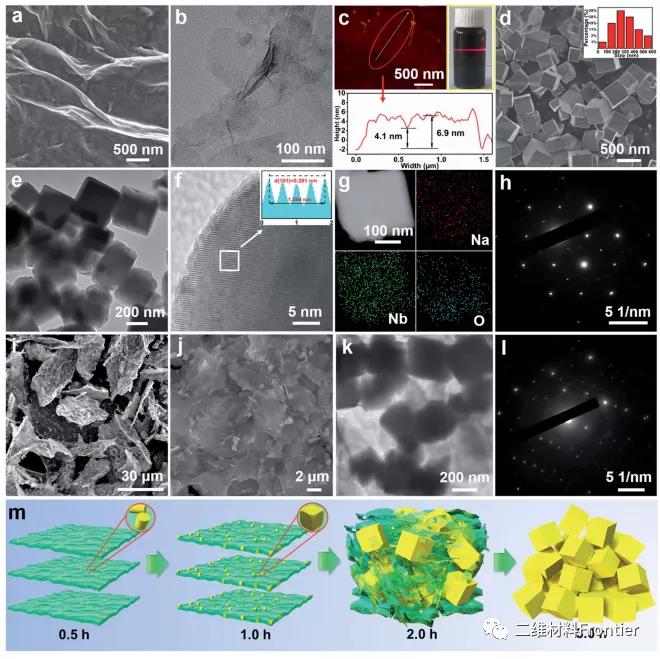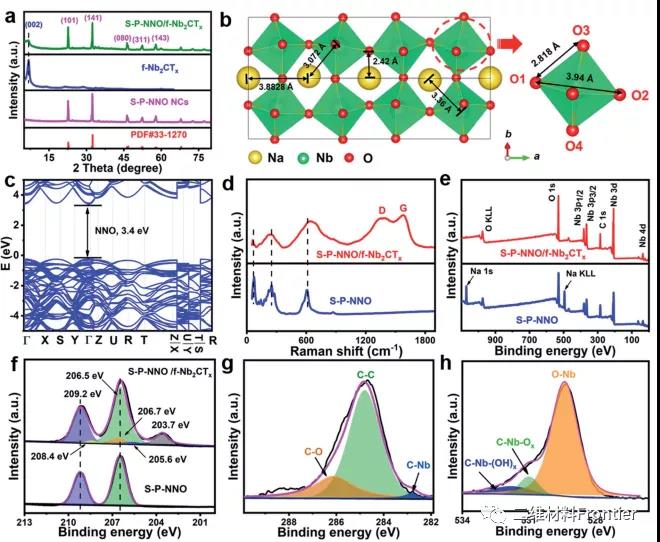Single crystal perovskite NaNbO3 nanotube/small-layer Nb2CTx MXene composite lithium ion capacitor


one. Article overview
Lithium ion capacitors (LICs) combine the advantages of lithium ion batteries and supercapacitors, with high energy/power density and long service life. However, the dynamic imbalance between the positive and negative electrodes greatly limits its further practical applications. In this paper, a simple hydrothermal alkalization method was used to prepare single-crystal perovskite NaNbO3 nanotubes (SP-NNO NCs) with a few layers of Nb2CTx MXene (f-Nb2CTx) as the precursor, and then they were combined with f -Nb2CTx assembly, prepared SP-NNO/f-Nb2CTx hybrid. Through comprehensive experiments, a deeper understanding of the formation mechanism of S-P-NNO nanocarbides has been obtained. By optimizing the composition and synergistic effect of S-P-NNO NCs and f-Nb2CTx, the optimized S-P-NNO/f-Nb2CTx nanocomposite has a reversible capacity of 157 mA hg-1 at 2.0 ag-1. LICs based on SP-NNO/f-Nb2CTx have an energy density of 56 Wh kg -1 and an ultra-high power density of 13 kWkg -1, as well as long-term cycle stability (75% retention after 4000 cycles). The inherent lithium storage mechanism of S-P-NNO/f-Nb2CTx anode was proposed by in-situ X-ray diffraction analysis. More meaningfully, the synthetic methods and unique insights designed here will stimulate the extensive development of new Nb-based oxides to the next generation of LICs and beyond.
Two, graphic guide

Shown in the picture. 1 (a) FESEM image, (b) TEM image, (c) AFM image of Tyndall effect of f-Nb2CTxNS colloidal solution. (d) FESEM and corresponding particle size distribution map (inset of panel d), (e) TEM, (f) HRTEM and measured interlayer spacing (inset of panel g), (g) STEM and corresponding EDX elements (Na, Nb, O) mapped image, (h) SAED image of SP-NNO NCS. (i and j) FESEM, (k) TEM image and (l) SAED mode of S-P-NNO/f-Nb2CTx hybridization. (m) Schematic diagram of the growth process of S-P-NNO nanocarbides.

Figure 2. (a) Wide-angle XRD spectra of S-P-NNO NCs, f-Nb2CTx NSs and S-P-NNO/f-Nb2CTx. (b) Crystal structure and (c) Band gap calculation of NNO. (d) Raman spectra and XPS measurement spectra of SP-NNO and SP-NNO/f- nb2ctx, and high resolution of SP-NNO/f- nb2ctx hybrid products (f) Nb 3d, (g) C 1s and (h) O 1s spectrum.

Figure 3. Electrochemical kinetic analysis of S-P-NNO/f-Nb2CTx electrode. (a) CV curve at different scan rates from 0.4 to 1.2mV1. (b) CV curve with false capacitance (blue) contribution at 0.8mV1. (c) At different scan rates, S-PNNO/ The normalized contribution ratio of the pseudo tolerance of f-Nb2CTx (red) and SP-NNO electrode (blue). (d and e) GITT diagram and (f) the corresponding changes in DLi of SP-NNO and S-P-NNO/f-Nb2CTx electrodes.

Figure 4. Characterization and electrochemical evaluation of the assembled S-P-NNO/f-Nb2CTx//AC device. (a) Schematic diagram of LICs. (b) As shown in the figure, CV curves at different scan rates. (c) Charge and discharge diagrams at different current densities. (d) Self-discharge curve. (e) Overview of leakage current. (f) Compare the Ragone diagram with other reported lic diagrams. (g) Long-term cycle characteristics under 1.0Ag-1.
3. Full text summary
In conclusion, in this work, the author first explored a simple hydrothermal alkalization method by using f-Nb2CTx NSs as a precursor to controllably manufacture S-PNNO NCs, and then combined SP-NNO with 2D f-Nb2CTx NSs are cleverly combined to obtain 3D layered SP-NNO/f-Nb2CTx hybrid as the competitive negative electrode of LIC. This unique strategy maximizes the respective advantages of S-P-NNO and f-Nb2CTx in efficient lithium storage. The f-Nb2CTx with good electronic conductivity enables the hybrid to have a three-dimensionally connected porous conductive network, which can be used for rapid Li+/electron transport. In addition, S-P-NNO NCS is uniformly dispersed on or between f-Nb2CTx nanoparticles, reducing the aggregation and self-weight accumulation of ultra-thin nanoparticles. Due to the synergistic effect between SP-NNO and f-Nb2CTx nanomaterials, the optimized SP-NNO/f-Nb2CTx nanomaterials show better lithium in terms of high rate capacity and cycle stability when used as lithium ion battery anodes. Storage performance. More importantly, an in-depth understanding of the formation of S-P-NNO nanocarbides and the internal lithium storage mechanism is helpful for comprehensive experimental analysis. The intelligent strategy and in-depth understanding of the article will provide meaningful guidance for the rational design/construction of niobium-based oxides in the future to realize the development of energy-related applications and other fields.



+86-18915413828(WhatsApp&WeChat)
Previous: Yury Gogotsi Team: Ten


